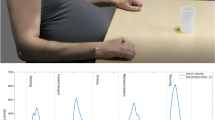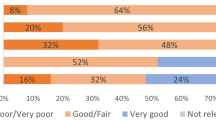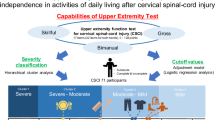Abstract
Study design:
Cross-sectional study.
Objectives:
(1) To examine whether the Klein–Bell ADL Scale (K–B Scale) discriminates cervical spinal cord injury (SCI) patients in daily activities and to explore its applicability in this group of patients. (2) To examine the association between basic ADL and upper extremity function. (3) To investigate if grip ability can be discerned in the scale.
Setting:
Spinal Cord Injury Unit, Sahlgrenska University Hospital, Göteborg, Sweden.
Methods:
Fifty-five patients with cervical SCI with no prior reconstructive hand surgery were included in the study. Analyses of the patient's independence were made according to the K–B Scale. Three additional analyses were carried out, the first examined whether the use of assistive devices and house and car adaptations influenced independence. The last two used different approaches to investigate whether arm and grip function could be detected in the K–B scale.
Results:
Raw score in the K–B Scale can discriminate for independence in daily activities but the scale's weight scheme does not function for cervical SCI patients. Assistive devices and car and house adaptations can compensate for dependence in daily activities. Lack of grip function decreases the patient's ability to become independent. Diagnosis-related activities cannot be assessed in all items.
Conclusion:
The K–B Scale's raw score was useful assessing daily activities in cervical SCI patients. Its reliability in conjunction with arm and grip function in patients with cervical SCI has yet to be proven.
Similar content being viewed by others
Log in or create a free account to read this content
Gain free access to this article, as well as selected content from this journal and more on nature.com
or
References
Waters RL, Adkins RH, Yakura JS, Sie I . Motor and sensory recovery following incomplete tetraplegia. Arch Phys Med Rehabil 1994; 75: 306–311.
Ditunno Jr JF, Young W, Donovan WH, Creasey G . The international standards booklet for neurological and functional classification of spinal cord injury. American Spinal Injury Association. Paraplegia 1994; 32: 70–80.
Lysack CL, Zafonte CA, Neufeld SW, Dijkers MP . Self-care independence after spinal cord injury: patient and therapist expectations and real life performance. J Spinal Cord Med 2001; 24: 257–265.
Welch RD, Lobley SJ, O'Sullivan SB, Freed MM . Functional independence in quadriplegia: critical levels. Arch Phys Med Rehabil 1986; 67: 235–240.
Burns AS, Ditunno JF . Establishing prognosis and maximizing functional outcomes after spinal cord injury: a review of current and future directions in rehabilitation management. Spine 2001; 26 (Suppl 24): S137–S145.
Dallmeijer AJ, van der Woude LH, Hollander PA, Angenot EL . Physical performance in persons with spinal cord injuries after discharge from rehabilitation. Med Sci Sports Exerc 1999; 31: 1111–1117.
Janssen TW, Dallmeijer AJ, Veeger DJ, van der Woude LH . Normative values and determinants of physical capacity in individuals with spinal cord injury. J Rehabil Res Dev 2002; 39: 29–39.
Yarkony GM, Roth EJ, Heinemann AW, Lovell L . Rehabilitation outcomes in C6 tetraplegia. Paraplegia 1988; 26: 177–185.
Krause JS, Broderick L . Outcomes after spinal cord injury: comparisons as a function of gender and race and ethnicity. Arch Phys Med Rehabil 2004; 85: 355–362.
Marino RJ, Rider-Foster D, Maissel G, Ditunno JF . Superiority of motor level over single neurological level in categorizing tetraplegia. Paraplegia 1995; 33: 510–513.
World Health Organization (WHO). International Classification of Functioning, Disability and Health (ICF). World Health Organization: Geneva 2001.
Cieza A, Geyh S, Chatterji S, Kostanjsek N, Ustun B, Stucki G . ICF linking rules: an update based on lessons learned. J Rehabil Med 2005; 37: 212–218.
Friden J, Ejeskar A, Dahlgren A, Lieber RL . Protection of the deltoid to triceps tendon transfer repair sites. J Hand Surg [Am] 2000; 25: 144–149.
Ejeskar A, Dahlgren A, Friden J . Split distal flexor pollicis longus tenodesis: long-term results. Scand J Plast Reconstr Surg Hand Surg 2002; 36: 96–99.
Ejeskar A, Dahllöf AG . Surgical rehabilitation in tetraplegia. In: Hurley R (ed). Rehabilitation of the Hand: Surgery and Therapy 4th edn. Mosby: St Louis 1995, pp 482–503.
Gansel J, Waters R, Gellman H . Transfer of the pronator teres tendon to the tendons of the flexor digitorum profundus in tetraplegia. J Bone Joint Surg Am 1990; 72: 427–432.
Rothwell A, Sinclair S . Upper limb tendon surgery for tetraplegia. Operative Orthopädie und Traumatologie 1997; 9: 199–212.
Sinnott KA, Dunn JA, Rothwell AG . Use of the ICF conceptual framework to interpret hand function outcomes following tendon transfer surgery for tetraplegia. Spinal Cord 2004; 42: 396–400.
Gresham GE, Labi ML, Dittmar SS, Hicks JT, Joyce SZ, Stehlik MA . The Quadriplegia Index of Function (QIF): sensitivity and reliability demonstrated in a study of thirty quadriplegic patients. Paraplegia 1986; 24: 38–44.
Klein RM, Bell B . The Klein–Bell ADL Scale Manual. University of Washington Medical School, Health Sciences Resources Centre SB-56: Seattle 1979.
Klein RM, Bell B . Self-care skills: behavioral measurement with Klein–Bell ADL scale. Arch Phys Med Rehabil 1982; 63: 335–338.
Law M, Usher P . Validation of the Klein–Bell activities of daily living scale for children. Can J Occup Ther 1988; 55: 63–68.
Titus MN, Gall NG, Yerxa EJ, Roberson TA, Mack W . Correlation of perceptual performance and activities of daily living in stroke patients. Am J Occup Ther 1991; 45: 410–418.
Bolding DJ, Llorens LA . The effects of habilitative hospital admission on self-care, self-esteem, and frequency of physical care. Am J Occup Ther 1991; 45: 796–800.
Kratz G, Soderback I, Guidetti S, Hultling C, Rykatkin T, Soderstrom M . Wheelchair users' experience of non-adapted and adapted clothes during sailing, quad rugby or wheel-walking. Disabil Rehabil 1997; 19: 26–34.
Medical Research Council. Aids to the Examination of the Peripheral Nervous System. HM Stationary Office: London 1976.
Moberg E . Two-point discrimination test. A valuable part of hand surgical rehabilitation, e.g. in tetraplegia. Scand J Rehabil Med 1990; 22: 127–134.
Cieza A et al. Linking health-status measurements to the international classification of functioning, disability and health. J Rehabil Med 2002; 34: 205–210.
Soderback I, Caneman G, Guidetti S, Hagsten BE . Klein–Bell ADL-Skala 1.0. Kind & Steinvik AB: Stockholm 1994.
Soderback I, Caneman G . Causes of dependence in personal care three years after stroke. Neurorehabilitation 1993; 3: 60–71.
Larsson EL, Aaro S, Oberg B . Activities and functional assessment 1 year after spinal fusion for paralytic scoliosis. Eur Spine J 1999; 8: 100–109.
Hagsten BE, Soderback I . Occupational therapy after hip fracture: a pilot study of the clients, the care and the costs. Clin Rehabil 1994; 8: 142–148.
Sandin C, Zachrisson G . ADL–Diagram 1.11 edn. Göteborg: Sandin Design 2003.
Klein RM, Bell B . The Klein–Bell ADL Scale Manual. University of Washington Medical School, Health Sciences Resources Centre SB-56: Seattle (undated).
Munro BH . Statistical Methods for Health Care Research 5th edn. Lippincott Williams & Wilkins: Philadelphia, Pa; London 2004.
Altman DG . Practical Statistics for Medical Research. Chapman and Hall: London 1991.
Napier JR . The prehensile movements of the human hand. J Bone Joint Surg Br 1956; 38-B: 902–913.
Bendz P . Systematization of the grip of the hand in relation to finger motor systems. A kinesiologic study using a new method for recording finger joint motions. Scand J Rehabil Med 1974; 6: 158–165.
Stineman MG, Jette A, Fiedler R, Granger C . Impairment-specific dimensions within the Functional Independence Measure. Arch Phys Med Rehabil 1997; 78: 636–643.
Catz A, Itzkovich M, Agranov E, Ring H, Tamir A . SCIM – Spinal Cord Independence Measure: a new disability scale for patients with spinal cord lesions. Spinal Cord 1997; 35: 850–856.
Fujiwara T, Hara Y, Akaboshi K, Chino N . Relationship between shoulder muscle strength and functional independence measure (FIM) score among C6 tetraplegics. Spinal Cord 1999; 37: 58–61.
Harvey LA, Crosbie J . Biomechanical analysis of a weight-relief maneuver in C5 and C6 quadriplegia. Arch Phys Med Rehabil 2000; 81: 500–505.
Gronley JK, Newsam CJ, Mulroy SJ, Rao SS, Perry J, Helm M . Electromyographic and kinematic analysis of the shoulder during four activities of daily living in men with C6 tetraplegia. J Rehabil Res Dev 2000; 37: 423–432.
Cohen HS . Neuroscience for Rehabilitation 2nd edn. Lippincott: Philadelphia 1999.
Gentilucci M, Toni I, Daprati E, Gangitano M . Tactile input of the hand and the control of reaching to grasp movements. Exp Brain Res 1997; 114: 130–137.
Collins DF, Knight B, Prochazka A . Contact-evoked changes in EMG activity during human grasp. J Neurophysiol 1999; 81: 2215–2225.
Monzee J, Lamarre Y, Smith AM . The effects of digital anesthesia on force control using a precision grip. J Neurophysiol 2003; 89: 672–683.
Moberg E . The Upper Limb in Tetraplegia: A New Approach to Surgical Rehabilitation. Thieme: Stuttgart 1978.
Ebied AM, Kemp GJ, Frostick SP . The role of cutaneous sensation in the motor function of the hand. J Orthop Res 2004; 22: 862–866.
Curt A, Dietz V . Traumatic cervical spinal cord injury: relation between somatosensory evoked potentials, neurological deficit, and hand function. Arch Phys Med Rehabil 1996; 77: 48–53.
Maissel G, Cohen M . Pin sensation is significant for self care function in quadraplegia. J Am Paraplegia Soc 1993; 16: 86.
Law MC, Baum CM, Dunn W . Measuring Occupational Performance: Supporting Best Practice in Occupational Therapy. Slack: Thorofare, NJ 2001.
Johanson ME, Murray WM . The unoperated hand: the role of passive forces in hand function after tetraplegia. Hand Clin 2002; 18: 391–398.
Rogers JC, Figone JJ . Traumatic quadriplegia: follow-up study of self-care skills. Arch Phys Med Rehabil 1980; 61: 316–321.
Coster WJ, Haley SM, Andres PL, Ludlow LH, Bond TL, Ni PS . Refining the conceptual basis for rehabilitation outcome measurement: personal care and instrumental activities domain. Med Care 2004; 42 (Suppl 1): I62–I72.
Streiner DL, Norman GR . Health Measurement Scales: A Practical Guide to Their Development and Use. 3rd edn. Oxford University Press: Oxford 2003.
Eakin P . Assessments of activities of daily living: a critical review. Part 1. Br J Occup Ther 1989; 52: 11–15.
Bowling A . Measuring Health: A Review of Quality of Life Measurement Scales. 3rd edn. Open University Pr.: Buckingham 2005.
Sonn U, Svensson E . Measures of individual and group changes in ordered categorical data: application to the ADL staircase. Scand J Rehabil Med 1997; 29: 233–242.
Tesio L . Measuring behaviours and perceptions: Rasch analysis as a tool for rehabilitation research. J Rehabil Med 2003; 35: 105–115.
Acknowledgements
We thank Anna Ekman for valuable help with statistics. This study was supported by grants from the Norrbacka-Eugenia Foundation, The Swedish Association of Survivors of Traffic Accidents and Polio foundation (RTP), The Foundation of Sunnerdahls Handicap Fund, The Swedish National Association for Disabled Children and Young People (RBU), The Capio Foundation, The Council of Research and Development of Gothenburg and Southern Bohuslan.
Author information
Authors and Affiliations
Rights and permissions
About this article
Cite this article
Dahlgren, A., Karlsson, AK., Lundgren-Nilsson, Å. et al. Activity performance and upper extremity function in cervical spinal cord injury patients according to the Klein–Bell ADL Scale. Spinal Cord 45, 475–484 (2007). https://doi.org/10.1038/sj.sc.3101993
Published:
Issue date:
DOI: https://doi.org/10.1038/sj.sc.3101993



